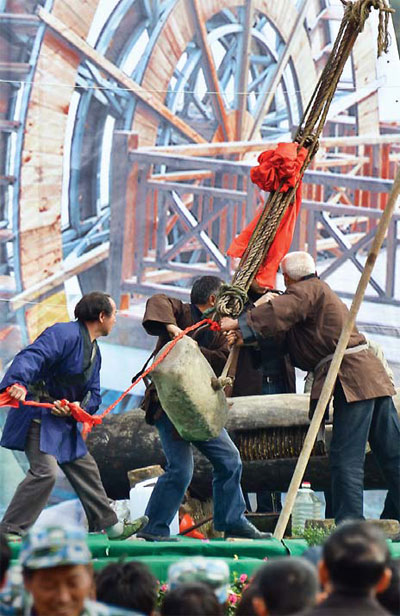Seeds of sweet fragrance
Updated: 2012-01-29 17:01
By Wu Ni (China Daily)
|
|||||||||||
 |
|
Villagers extract camellia oil using 100-year-old tools in Suichang county, Lishui of Zhejiang province. [Provided to China Daily] |
November has been the busiest season for members of Zhangshan village, in Zhejiang province's Songyang county. This is the time when every household begins the process of extracting oil from camellia seeds, a tradition that has lasted for hundreds of years.
"Camellia seeds that are scattered on the ground bake in the sunshine for nearly a month before we start shucking off the rinds and grind them in the stone mill," said Ye Ping, the Village Party Branch Secretary. "That's when the seeds are ready for oil extraction."
Camellia is an evergreen shrub with shiny leaves and rose-like flowers - a natural green food also used as a skin-care product. It contains 90 percent of the unsaturated fatty acid that a human body needs.
About 2.45 million mu (1,633 square meters) of camellias are planted in Zhejiang, making the province the fourth-largest camellia producer. Songyang county, where 117,000 mu of camellias grow annually, is known as the "land of camellias".
Camellia oil has always been a major source of income for many villagers living in the deep mountains.
Hundreds of years ago, villagers carried loads of extracted oil and traveled over hills and dales to trade the oil for other daily necessities, in bazaars outside the mountains.
The road their predecessors walked became the famed Camellia Oil Path.
"The ancient path connects the village with the outside world. We can reach Jinhua, Lishui and Wenzhou through this path," Ye said.
Ye, born in a family that has planted camellias for generations, said that a camellia sapling would start bearing seeds after at least four years. A mature camellia tree produces about 50 kilogram of seeds, yielding about 10 kg oil.
In Xialiao'er Village in Songyang county, most camellia trees in the mountains have grown for more than 100 years. Among them, a tree called the king of camellias, has produced more than 109 kg of seeds this year.
Owned by villager Lan Songgui, the tree looks like a huge and prosperous green umbrella.
After a hard day's work, Lan likes to lean on the trunk or run his hand over the roots. He said he felt connected to the tree that existed since the time of his great-grandfather.
Similar to Songyang county, Jinzhu town of Suichang county beside the Wuxijiang reservoir, is an important base of producing camellia oil. The ancient ways of planting camellia trees and extracting oil have been well preserved for more than 2,300 years.
In Jinzhu town, the fragrance of camellia oil emanating from Wangheche Handmade Oil Workshop, a time-honored brand of more than 400 years, fascinates many people in the winter.
A waterwheel, a millstone, a camphor wood slot and a stone pile driver form parts of the oldest and most primitive machine for extracting camellia oil.
Forty-eight-year-old villager Zhu Lewen is the manager of the workshop. "The techniques of making crude camellia oil were passed to me by my ancestors. Although new machines are widely in use, handmade oil is many local people's favorite."
Zhu said that the camellia oil extracted with traditional techniques gave out a marvelous fragrance when cooked in a pot.
A few days before the Frost's Descent, one of the 24 solar terms in Chinese lunar calendar - which is typically in late October - villagers go to the mountains to pick camellia seeds. These are packed in bags and stored in a dry area for a week.
When the weather is fine and the sun shines brightly, the seeds are scattered on bamboo mats and exposed to the sun for a week.
When the green rinds crack under the heat of the sun, villagers draw the black seeds out. These black seeds are baked in sunshine for about half a month till they are totally dry and ready for oil extraction.
"Every step is important if you want to make high-quality camellia oil," Zhu said. "If the seeds are not completely dried, the crude oil will contain a lot of residue which will affect the taste."
The dry seeds are grinded to powder in the stone mill and the powder is stirred slowly on a mild fire. Then it is braised in the bamboo steamers, made into pancake shape and put into the 2-meter-long and 0.4-meter-wide wood slot.
As the 100kg stone pile driver rhythmically hits the wood slot, streams of camellia oil flow out.
One kilogram of pure camellia oil costs about 70 yuan ($11). The more widely-recognized brands, high on nutrition and other values, cost more.
Guo Qianfang, a manager of a local camellia oil producer, said that his company placed orders for camellia seeds with farmers since the beginning of October, but the supply kept falling short of the demands.
"Camellia essential oil is used in massage, the seed powder is used in washing powder, and there is also camellia facial cream that helps smooth wrinkles," Guo said. "Every part of a camellia seed is a treasure and can be made use of."
Today's Top News
President Xi confident in recovery from quake
H7N9 update: 104 cases, 21 deaths
Telecom workers restore links
Coal mine blast kills 18 in Jilin
Intl scholarship puts China on the map
More bird flu patients discharged
Gold loses sheen, but still a safe bet
US 'turns blind eye to human rights'
Hot Topics
Lunar probe , China growth forecasts, Emission rules get tougher, China seen through 'colored lens', International board,
Editor's Picks

|

|

|

|

|

|





